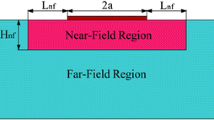Abstract
This paper presents a numerical method based on a three dimensional boundary element–finite element (BEM–FEM) coupled formulation in the time domain. The proposed model allows studying soil–structure interaction problems. The soil is modelled with the BEM, where the radiation condition is implicitly satisfied in the fundamental solution. Half-space Green’s function including internal soil damping is considered as the fundamental solution. An effective treatment based on the integration into a complex Jordan path is proposed to avoid the singularities at the arrival time of the Rayleigh waves. The efficiency of the BEM is improved taking into account the spatial symmetry and the invariance of the fundamental solution when it is expressed in a dimensionless form. The FEM is used to represent the structure. The proposed method is validated by comparison with analytical solutions and numerical results presented in the literature. Finally, a soil–structure interaction problem concerning with a building subjected to different incident wave fields is studied.


















Similar content being viewed by others
Change history
17 May 2019
In the original publication of the article, the second author���s name was missed.
17 May 2019
In the original publication of the article, the second author���s name was missed.
References
Araújo FC, Mansur WJ, Nishikava LK (1999) Linear \(\theta \) time-marching algorithm in 3D BEM formulation for elastodynamics. Eng Anal Bound Elem 23(10):825–833
Barber JR (1996) Surface displacements due to a steadily moving point force. Trans ASME J Appl Mech 63(2):245–250
Bode C, Hirschauer R, Savidis SA (2002) Soil–structure interaction in the time domain using halfspace Green’s functions. Soil Dyn Earthq Eng 22(4):283–295
Chao CC (1960) Dynamical response of an elastic half-space to tangential surface loadings. J Appl Mech ASME 27(3):559–567
Clough RW, Penzien J (1975) Dynamic of structures. McGraw-Hill, New York
Clouteau D, Cottereau R, Lombaert G (2013) Dynamics of structures coupled with elastic media—a review of numerical models and methods. J Sound Vib 332(10):2415–2436
Ditzel A, Herman GC, Drijkoningen GG (2001) Seismograms of moving trains: a comparison of theory and measurements. J Sound Vib 248(4):635–652
Domínguez J (1993) Boundary elements in dynamics. Computational Mechanics Publications and Elsevier Aplied Science, Southampton
Eringen AC, Suhubi ES (1975) Elastodynamics, linear theory, vol 2. Academic Press, New York
Galvín P, Domínguez J (2007) Analysis of ground motion due to moving surface loads induced by high-speed trains. Eng Anal Bound Elem 31(11):931–941
Galvín P, Romero A, Domínguez J (2010) Fully three-dimensional analysis of high-speed train–track–soil–structure dynamic interaction. J Sound Vib 329(24):5147–5163
Galvín P, Romero A (2014) A MATLAB toolbox for soil–structure interaction analysis with finite and boundary elements. Soil Dyn Earthq Eng 57:10–14
Heidebrcht C, Stafford-Smith B (1973) Approximate analysis of tall wall-frame structures. Struct Div 99:199–221
Johnson LR (1974) Green’s function for Lamb’s problem. Geophys J R Astron Soc 37(1):99–131
Kausel E (2010) Early history of soil–structure interaction. Soil Dyn Earthq Eng 30(9):822–832
Kausel E (2013) Lamb’s problem at its simplest. Proc R Soc A Math Phys Eng Sci 469(2149):20120462
Mantic V (1993) A new formula for the C-matrix in the Somigliana identity. J Elast 33(3):191–201
Marrero M, Domínguez J (2003) Numerical behavior of time domain BEM for three-dimensional transient elastodynamic problems. Eng Anal Bound Elem 27(1):39–48
Mooney HM (1974) Some numerical solutions for Lamb’s problem. Bull Seismol Soc Am 64(2):473–491
Newmark NM (1959) A method of computation for structural dynamics. ASCE J Eng Mech Div 85(1):67–94
Oliveto G, Santini A (1992) A simplified model for the dynamic soil–structure interaction of planar frame-wall systems. Eng Struct 15:431–437
Pekeris CL (1955) The seismic surface pulse. Proc Natl Acad Sci USA 41:469–480
Rizos DC, Karabalis DL (1994) An advanced direct time domain BEM formulation for general 3-D elastodynamic problems. Comput Mech 15(3):249–269
Rizos DC, Karabalis DL (1998) A time domain BEM for 3-D elastodynamic analysis using the B-spline fundamental solutions. Comput Mech 22(1):108–115
Romero A, Galvín P, Domínguez J (2013) 3D non-linear time domain FEM–BEM approach to soil–structure interaction problems. Eng Anal Bound Elem 37(3):501–512
Schanz M (1999) A boundary element formulation in time domain for viscoelastic solids. Commun Numer Methods Eng 15(11):799–809
Triantafyllidis T (1991) 3-D time domain BEM using half-space Green’s functions. Eng Anal Bound Elem 8(3):115–124
Wolf JP (1985) Dynamic soil–structure interaction. Prentice Hall, Englewood Cliffs
Zienkiewicz OC, Taylor RL (1967) The basis. The finite element method, vol I. McGraw-Hill, New York
Acknowledgments
This research was funded by the Spanish Ministry of Economy and Competitiveness (Ministerio de Economía y Competitividad) through research project BIA2010-14843. Financial support is gratefully acknowledged. The support given by the Andalusian Scientific Computing Centre (CICA) is also gratefully.
Author information
Authors and Affiliations
Corresponding author
Rights and permissions
About this article
Cite this article
Galvín, P., Romero, A. A 3D time domain numerical model based on half-space Green’s function for soil–structure interaction analysis. Comput Mech 53, 1073–1085 (2014). https://doi.org/10.1007/s00466-013-0949-1
Received:
Accepted:
Published:
Issue Date:
DOI: https://doi.org/10.1007/s00466-013-0949-1




